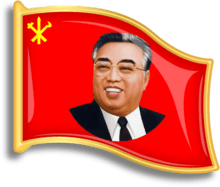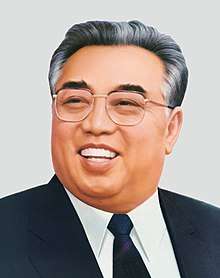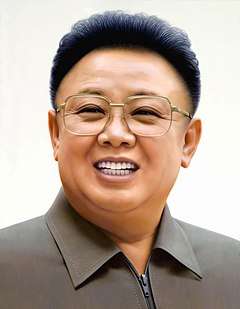Kim Il-sung and Kim Jong-il badges
Kim Il-sung and Kim Jong-il badges are lapel pins with portraits of the eternal leaders of North Korea, Kim Il-sung and Kim Jong-il. They have been made since the late 1960s. The badges are produced by the Mansudae Art Studio. There are more than 20 different designs, some of which are more sought-after than others. Ordinary North Koreans wear simple designs with a portrait of Kim Il-sung, whereas those higher up in the society prefer badges that have both Kim Il-sung and Kim Jong-il portrayed.

The badges were inspired by Chairman Mao badges. Unlike their Chinese counterparts, which were never compulsory to wear, the North Korean badges have been a mandatory part of the attire for most of their history. As such, they are culturally more important than Mao badges ever were,[1] and are a key part of North Korea's cult of personality.[2] According to Jae-Cheon Lim, the badges are:
[a] formative symbol depicting the North Korean leaders. ... Wearing a leader badge is an identity symbol showing that North Koreans belong to their leader, thus distinguishing themselves from foreign citizens. Unlike other leader symbols, the badge is portable. ... Thus it is a symbol fulfilling the idea that the leaders are always with the people.[3]
They have also been compared to cross necklaces worn by Christians as a sign of devotion to a cause, increasing the parallels drawn overall between religion and the North Korean cult of personality.[4]
History
.jpg)
The inspiration for the badges were Chairman Mao badges worn by the Chinese during the Cultural Revolution,[5] although North Korean propaganda attributes the idea to Kim Jong-il.[6] It has been suggested by high-ranking defector Hwang Jang-yop that the Kapsan Faction Incident in 1967 triggered the systematic intensification of Kim Il-sung's cult of personality in general and the introduction of the badges in particular.[7]
Badges bearing the portrait of Kim Il-sung first appeared in the late 1960s when the Mansudae Art Studio started making them for Workers' Party of Korea cadres,[8] who started wearing them after the Kapsan Faction Incident.[3] Mass-production followed in November 1970,[9] after a decree by Kim Il-sung. The very first badges with portraits were produced by the party's Propaganda and Agitation Department. This batch of badges featured "a stern-looking portrait of Kim Il Sung with his mouth firmly closed". They were called "Party Badges" because only party officials would wear them, but ordinary North Koreans could also illegally buy them in hopes of a higher social status.[10] These badges were made a mandatory part of the attire of every North Korean from Kim's 60th birthday on 15 April 1972 onward,[9] when they came in three classes: for party members, one for adults, and one for students.[11] Most would start wearing one from there on,[10] and by 1980 virtually everyone wore the badges.[11] The Kim Il-sung badge was redesigned after the his death to feature a smiling portrait.[10]
Since the North Korean famine in the 1990s, the government has lessened its control on making sure that badge regulations are complied with. Many people ceased wearing the badges in public, and in 2004 the government reportedly responded by allowing this practice.[12] For a time, at least, only party members were required to wear one, though most others would continue to do so regardless.[13]
Badges bearing the portrait of Kim Jong-il appeared in 1982, and many started to wear one alongside their Kim Il-sung badges.[5] The first badge containing both Kim Il-sung and Kim Jong-il appeared in the 1980s, but is different from the present double badge reserved for security services cadres.[14] Kim Jong-il badges were discontinued in the 1990s following his alleged remark: "How can I be presented on the same level as our sole 'sun', Kim Il Sung?". In 1992, in time for Kim Jong-il's 50th birthday, a pin with his face only reappeared. It, too, was unpopular due to his known reluctance to be elevated to the level of his father. Kim Jong-il badges began to be worn more widely only around the year 2000,[10] with a renewed design,[3] and badges featuring both Kims only recently.[10]
The round designs were the oldest types. The very first round design in 1953 featured Kim Il-sung's side profile in military uniform, much like their Chinese counterparts. Kim's face from the front began to be used in the 1980s. Rectangular badges appeared in the 1980s and were at first reserved for those working in state security organizations. The flag-shaped badges began to be made in the early 1980s. They featured a symbol related to a party, state, or youth organization. The one bearing the emblem of the Workers' Party became the most popular.[3]
After the death of Kim Jong-il in December 2011, party officials started to wear the Kim Jong-il badge next to the Kim Il-sung one. Then, in April 2012, the double badge was reintroduced in its current form.[10]
Badges with both leaders have been recently used by people traveling between regions as an item for bartering in the North Korean gray market. Previously, methamphetamine was used for bartering before various crackdowns made the practice hard. Badges eventually replaced drugs despite falling prices.[15] In Pyongyang, too, where money and prized items are in short supply, the badges have value. This makes them a target for pickpockets.[8] Criminals, who are often wealthier than ordinary North Koreans, usually choose to wear the expensive types of badges as status symbols.[16]
Wearing
.jpg)
Virtually all North Koreans wear the badges.[17] North Koreans start to wear the badges when they turn 12 years old. It is placed above their Korean Children's Union badges.[9] Citizens above the age of 16 are required to wear the badges whenever they leave home.[18]
Respect for the badges is enshrined in the Ten Principles for the Establishment of a Monolithic Ideological System, which mandate that they "must be treated with reverence and protected with utmost care".[19] If someone is caught outside their home without a badge, they are faced with explaining themselves at the next mutual criticism session.[14] The badges are given to eligible North Koreans for free,[8] and are acquired through one's workplace or school.[13][11] Losing, or selling, a badge results in one having to prove that they have lost the badge without a malicious intent before they are given a new one.[8] Lacking a badge has also been associated with transgression because sometimes people who professed "anti-Kim" behavior had their badges confiscated.[11]
A North Korean may own several different badges that they have attained at different stages of their life,[14] two or three on average, but some have many more.[10]
The badges are usually not sold to tourists,[12] but can be conferred upon them for loyalty.[10] Recently, badges have been smuggled out of the country for sale and can be found in Chinese cities in particular,[12] although selling them is illegal in China as well. Both authentic and counterfeit badges are sold in Tumen.[20] Most badges found outside of the country are counterfeits,[13] such as those regularly on sale in Dandong.[21] As of late, badges have been known to be for sale to foreigners in North Korea as well. In the future, the badges are anticipated to become veritable collector's items.[12]
The badges are worn on inner garments only,[10] either on the lapel or a shirt,[4] but not on outwear coats. Usually, the badges are worn on the left side of a garment, over the heart.[10] There are atypical ways of wearing the badges that are considered fashionable by North Koreans, the youth in particular.[12] Schoolchildren and teenagers use the badges to "perk up" their uniforms.[8] One such way is to wear the badge at the very edge of one's garment,[12] for which children of upper-class families in Pyongyang in particular are known.[22]
Although it is mandatory to wear a badge, North Korean officials sometimes claim that it is done out of pure loyalty.[1] Most North Koreans simply prefer to wear them because it is much safer to do so.[12] The badges are taken off on certain rare occasions, such as when entering a place of worship.[23]
North Koreans traveling abroad also almost always wear the badges,[17] for which they are sometimes ridiculed by foreigners.[24]
Types
.jpg)
The badges are designed and made by the Mansudae Art Studio.[14]
The badges come in different shapes and sizes. Unlike in China, where Chairman Mao badges were diverse because their production was not overseen by the government, North Korean badges have relatively little variation.[6] All in all, there are more than 20 different designs.[25] The size, shape, coloring, and type of metal of the design is indicative of the social status and institutional affiliations of the person wearing it.[22] For instance, party youths wear large round badges, whereas common people wear smaller round badges. While most badges only feature a portrait of Kim Il-sung, there are two exceptions. The most prestigious type has both Kim Il-sung and Kim Jong-il against a red banner. No other design features both leaders. The design is reserved to high-level Workers' Party of Korea officials only. It is so rare that seeing one "can send many a minor North Korean bureaucrat into a stupor". The other exception is badges with the portrait of Kim Jong-il only. They are worn by security services cadres and are also considerably rare.[14]
Some feature the leader in a Western suit, the others in military attire, or some other type of clothing.[3]
Before Kim Jong-un had been confirmed as Kim Jong-il's successor and Kim Jong-chul was groomed as the country's next leader, a limited set of Kim Jong-chul badges were reportedly made and given to cabinet, party, and army officials.[26] There are no Kim Jong-un badges,[27] but experts think that it is a matter of time before there will be.[28]
See also
- Chairman Mao badge
- Culture of North Korea
- Kim Il-sung and Kim Jong-il portraits
- List of things named after Kim Il-sung
- Orders and medals of North Korea
- Songbun
References
- Hoare, James E. (2012). "Badges". Historical Dictionary of Democratic People's Republic of Korea. Lanham: Scarecrow Press. p. 57. ISBN 978-0-8108-7987-4.
- Hokkanen, Jouni (2013). Pohjois-Korea: Siperiasta itään [North Korea: East of Siberia] (in Finnish). Helsinki: Johnny Kniga. p. 19. ISBN 978-951-0-39946-0.
- Lim 2015, p. 32.
- Ferrante, Joan (2005). Sociology: A Global Perspective (Sixth ed.). Belmont: Cengage Learning. p. 89. ISBN 0-495-00561-4.
- Kwon & Chung 2012, p. 142.
- Lynn 2007, p. 101.
- Lim 2015, p. 24.
- French 2007, p. 16.
- Lankov 2007, p. 7.
- Hyowon Shin (30 July 2013). "Behind the Evolution of North Korea's Leadership Loyalty Badges". NK News. Retrieved 19 January 2017.
- Portal, Jane (2005). Art Under Control in North Korea. London: Reaktion Books. p. 86. ISBN 978-1-86189-236-2.
- Lankov 2007, p. 9.
- Lankov, Andrei (3 May 2012). "Potent Portraits in North Korea". Asia Times Online. Retrieved 5 February 2017.
- Lankov 2007, p. 8.
- Sung-hui Moon (30 January 2015). "Illegal Sale of 'Double Portrait' Lapel Pins Flourishes in North Korea". Translated by Hanna Lee. Written in English by Roseanne Gerin. Radio Free Asia. Retrieved 19 January 2017.
- French 2007, p. 23.
- Sung Chul Yang (10 March 2010). "Understanding the North Korean Political Framework". In Soong Hoom Kil; Chung-in Moon (eds.). Understanding Korean Politics: An Introduction. Albany: State University of New York Press. p. 300. ISBN 978-0-7914-9101-0.
- Lankov, Andrei (2015). The Real North Korea: Life and Politics in the Failed Stalinist Utopia. Oxford: Oxford University Press. p. 53. ISBN 978-0-19-939003-8.
- John H. Cha; K. J. Sohn (2012). Exit Emperor Kim Jong-il: Notes from His Former Mentor. Bloomington: Abbott Press. p. 47. ISBN 978-1-4582-0217-8.
- Steele, Lawrence (30 November 2015). "In Tumen, Hawkers Find N.Korean Leader Pins a Tough Sell". NK News. Retrieved 5 February 2017.
- Willoughby 2014, p. 261.
- Willoughby 2014, p. 67.
- Hoare, James E. (2012). "Religion". Historical Dictionary of Democratic People's Republic of Korea. Lanham: Scarecrow Press. p. 322. ISBN 978-0-8108-7987-4.
- Kwon & Chung 2012, p. 143.
- Herman, Luke (15 November 2012). "Brace Yourselves, The Kim Jong Un Badges Are Coming". NK News. Retrieved 5 February 2017.
- Lynn 2007, p. 120.
- Willoughby 2014, p. 30.
- MacKinnon, Mark (23 August 2012). "North Korea's Kim Jong-un: Portrait of a Leader in the Making". The Globe and Mail. Retrieved 5 February 2017.
Works cited
- French, Paul (2007). North Korea: The Paranoid Peninsula: A Modern History (Second ed.). London: Zed Books. ISBN 978-1-84277-905-7.CS1 maint: ref=harv (link)
- Kwon, Heonik; Chung, Byung-Ho (2012). North Korea: Beyond Charismatic Politics. Lanham: Rowman & Littlefield Publishers. ISBN 978-1-4422-1577-1.CS1 maint: ref=harv (link)
- Lankov, Andrei (2007). North of the DMZ: Essays on Daily Life in North Korea. Jefferson: McFarland. ISBN 978-0-7864-5141-8.CS1 maint: ref=harv (link)
- Lim, Jae-Cheon (2015). Leader Symbols and Personality Cult in North Korea: The Leader State. Oxon: Routledge. ISBN 978-1-317-56741-7.CS1 maint: ref=harv (link)
- Lynn, Hyung Gu (2007). Bipolar Orders: The Two Koreas Since 1989. London: Zed Books. ISBN 978-1-84277-743-5.CS1 maint: ref=harv (link)
- Willoughby, Robert (2014). North Korea: The Bradt Travel Guide (Third ed.). Chalfront: Bradt Travel Guides. ISBN 978-1-84162-476-1.CS1 maint: ref=harv (link)
External links
| Wikimedia Commons has media related to Badges of North Korea. |


